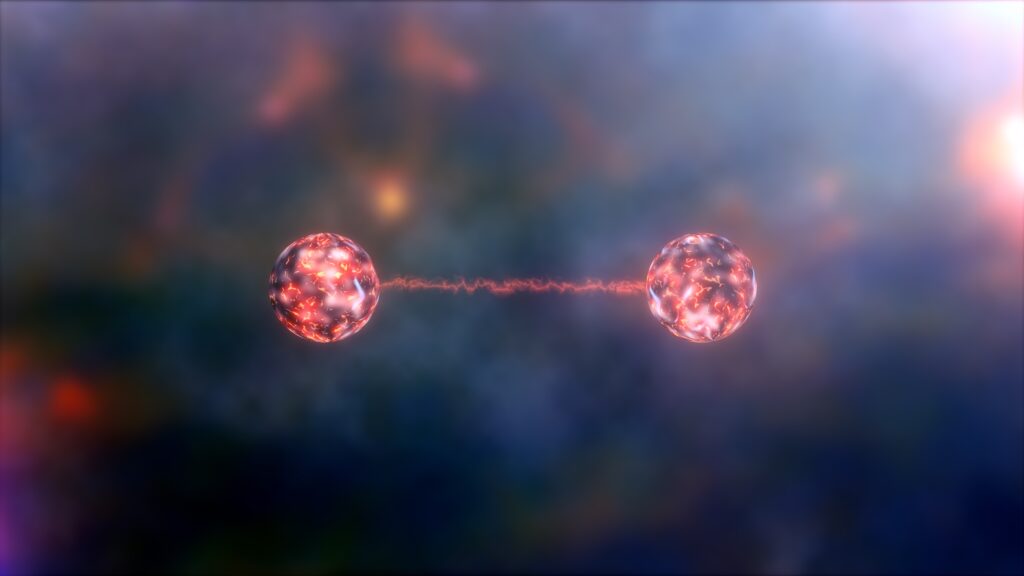Playing in the field: The nature of children and consciousness
Reading | Psychology
![]() Donna Thomas, PhD | 2022-08-07
Donna Thomas, PhD | 2022-08-07

Through their play and the extraordinary inner experiences they report, children reveal a broader, non-local, decentered and shared self. Because children are less conditioned than adults, this may be a clue to the true nature and scope of self and reality, as well as the role of consciousness within it, argues Dr. Donna Thomas.
Interest in children’s unexplained experiences, such as telepathy or imaginary friends, tends to be centered on the question of whether such experiences are real. Yet, once we start to consider the nature of childhood, the focus shifts more towards questions over definitions of ‘real,’ in terms of how reality is defined when making claims about children and their experiences. Children navigate the everyday world through imagination and play, states of mind often considered subjective fantasy and, as a result, never afforded time to be queried with children. In our modern age, it isn’t only younger children who are navigating the imaginal realms; older children and teens, too, spend most of their time in cyberspace. Not only does this affect children’s cognitive capabilities—for example, enhancing metacognition, spatial visualization and perceptual speed—video gaming can catalyze states of consciousness similar to those found in activities such as meditation and yoga nidra.1 Studies show how video gaming was found to be an amplifier of experience, like prayer or meditation. A sharp correspondence has been found between a high prevalence of lucid dreaming and game playing across teenage populations.2
An absence of research into children and consciousness lends itself to assumptions made about children’s ways of being and subjective experiences. Autism is a good example of this. Despite the increasing number of children diagnosed with autism, there is no clear pathophysiology. Autism is still poorly understood and there isn’t a straightforward aetiology [Editor’s note: cause of a health condition] for its emergence. Autism is defined scientifically through different lenses—for instance, in terms of genetics—and rarely explored from the perspectives of children with autism. In 2006, William Stillman published Autism and the God Connection, a book that aimed to redefine the autistic experience. Stillman shares the story of Boone, a five-year-old boy with autism. Boone’s mother reported that six months prior to the events in New York on September 11, 2001, Boone drew over 100 clocks, each with the time set to 9:11. Drawings of balls of fire and smoke from tall buildings with many windows were also created by Boone. What makes children with autism more open to experiences such as precognition may be their acute sensitivities—such as sensory, emotional, cognitive and spiritual sensitivities—all caused by differences in their neurological development.3
Earlier studies into children and ESP began to show how experiences such as telepathy or telekinesis could be extensions of our natural cognitive functions,4 especially for children who experience a deficit in areas of their cognitive functioning, such as non-verbal children. In this way, experiences such as telepathy and clairvoyance would be extensions of normal perceptual processes. For example, precognition would be the reversal of memory and telekinesis an extension of motor abilities in children. In other words, these experiences are not super or paranormal; they naturally occur in response to a child’s need to survive and interact with the environment.5 In the late seventies, parapsychologist Alex Tanous co-authored a book with Katherine Donnelly that offered advice to adults for supporting their psychic child. Tanous & Donnelly advanced thinking around children and psi towards the idea that children could naturally enter altered states of consciousness, such as bilocation, or being in two spots at the same time.
Playing in consciousness
For adults, reality can be clearly defined by what is logical or possible and shared by many people, and there can be clear instances when a child miscalculates an illusion, such as mistaking an adult dressed as a teddy bear for an actual big teddy bear. This doesn’t mean that children’s imaginary worlds or playful activities don’t hold some aspect of a reality that goes beyond usual ideas of a fixed, physical world. For example, play is a child’s activity that is mostly taken for granted; very little is known about the nature of play. Social scientists may speculate that it is a socially constructed activity where children will mimic the world of adults. This claim may carry some validity, but there could be far more to play than meets the eye. Play cuts across species and carries many benefits for wellbeing. Playing entrains or brings into sync brain waves and physiological systems in mothers and children. When children play, they weave strands of ancestral inheritance, embodying self in material and non-material spaces.5 Creativity is often viewed as a product of play, but perhaps the impulse to create may in fact cause children to play. As the playwright George Bernard Shaw reminds us, “we don’t stop playing because we grow old; we grow old because we stop playing.”
In early religious scripture, play is synonymous with a joyful state of presence. The literature around altered states of consciousness in adults refers to this as transcendence or states of oneness. Play, in its deepest form, entails a transcendence of the norm, a state of consciousness from which different expressions, such as freedom, happiness, connectedness and creativity, emerge. William James noted how ritual and play induced transmarginal consciousness, states that are subtly veiled in the everyday.7 Trance has been linked to ritual and play, with one class of play referred to as the ilinx, the Greek word for whirlpool.8 Ilinx is a type of trance state, “an attempt to momentarily destroy the stability of perception and inflict a kind of voluptuous panic upon an otherwise lucid mind … surrendering to a kind of spasm, seizure or shock which destroys reality with a sovereign brusqueness.” In children, this may be seen in spinning around until they fall over in fits of laughter, or moving in great rotations on playground equipment. In adult ritual, this may be seen in the whirling dervishes or the parachuter hurtling to earth from the plane. In Children’s Folklore: A Handbook, Elizabeth Tucker discusses dangerous play, in the form of nonsexual choking games played by children, that are similar to adult and adolescent versions of asphyxiation. Children enjoy this form of play because of the ecstatic feelings associated with oxygen deprivation. It becomes clear that there are many natural and subtle ways that children may enter different states of consciousness that are conducive to experiences considered anomalous.
Consciousness and self
Psychoanalyst Donald Winnicott (1896-1971) saw play as a state, rather than a functional activity. Winnicott used the term ‘transitional’ to refer to a space between inner and outer reality. A transitional object, such as a toy, is used to bridge inner and outer worlds. Despite the transitional object being viewed as an external object by an outside observer, Winnicott suggests it is experienced by the infant as being neither self, other, internal or external, but on the boundary between these as a point of intersection. A transitional object is one “about which the question ‘is it created by me, or does it come from the outside’ cannot be meaningfully asked, because it does not exist in any of these psychic realms.”9 Infants’ perceptions of objects being part of who they are is seen as an illusory act. This illusion, according to Winnicott, is an infant’s sense of being omnipresent, creating the external world and perceiving everything as a facet of one’s own subjectivity. But perhaps, unlike what is suggested by Winnicott, there is no illusion of omnipresence; rather, children see through the separation between so-called objects, such separation being the illusion. Children seem to intuit a subjectivity that extends far beyond the bundle of thoughts, sensations and perceptions known as ‘me.’
Young children, in their pre-egoic state, experience self and others, inner and outer worlds, as one homogenous experience. Jung observed how very young children still have “an awareness of mythological contents … haunted by a constant yearning to remain with or return to the original vision.”10 Others have noted the “original vision” as the dynamic ground of being or, in Lacanian terms, “the register of the real.”11 Some scholars have argued that children’s pre-egoic states are chthonic, rooted in a dark underworld—rather than the transcendental realms—only accessible to those who already sport an ego, such as adults.12 Psychologists have argued that children possess a natural joy, wonder and connection, character virtues that Plato and Aristotle saw as intrinsic to the “nature of soul.” Although the influential child psychologist, Jean Piaget, described children as “artificialists,” egocentric and coerced by their parents when sharing their intuitions about the nature of reality, contemporary research suggests this is not the case. Instead, children are “natural theists”13 who intuit teleological explanations of a universe imbued with meaning and purpose.
As adults, would we so easily dismiss children as fantasists if a new understanding of the nature of consciousness and reality became available? Today, the mainstream model of materialism—which still carries a hegemony over child development theories, research and systems that support children—is being questioned.
Ideas of the world through the I’s of children
If ideas of the world are to be formed from the living experiences of children, it becomes clear that materialism, as the dominant model of reality, doesn’t cut it. Not only does materialism lack explanatory power for making sense of children’s ways of being and experiences, it also denies them. A process of elimination may be warranted to find better ontologies that could support not just our understanding of children, but also inform wider social transformation. To stay committed to the living experiences of children, an idea of the world needs to accommodate several qualities children demonstrate:
- A sense of I-ness or Me-ness that carries qualities of being collective, connected and shared, rather than located and individual.
- Experiences that go beyond usual notions of personhood, space and time.
- Appeals to nature.
- Natural virtues such as creativity, wisdom and intuition.
Challenging mainstream materialism requires a courage to break free from normative systems of thought, which determine not only our ideas of self and the world, but also our livelihoods, credibility and acceptance within research institutions. Panpsychism, as one alternative, may not require this type of bravery, as it stays safely within the parameters of materialism, simply claiming consciousness to be a fundamental existent in matter. But panpsychism has a problem with the subject, as it cannot explain how several smaller subjects—such as those at the level of subatomic particles—combine to make larger subjects such as you and me. To circumvent this, advocates of panpsychism propose even an elimination of self, of subjectivity, to address the subject combination problem.14 After all, if there is no self, there is no problem. But although there are legitimate doubts about a type of self that we tend to identify with—a subject that is located, centered and individual—children reveal a self, a subject, that is non-local, decentered and shared. Indeed, infants and children’s ways of being, their sense of omnipresence and intuitive explanations of the world, suggest that there is a subject: something to which experience is known. Staying committed to the living experiences of children entails a need to explain their sense of
ipseity or selfhood … a conscious presence devoid of form and objects, yet ready to assume ordinary qualitative tones and to serve as the apprehending recipient of objects if the right conditions for the emergence of an individual conscious perspective materialize. (Shani & Keppler 2018)
For Shani & Keppler, consciousness entails a state of subjectivity described as a pure subject, which does not have individual perspectives. Individual subjects form when the pure subject is conditioned through different forces, a little like the factors needed to turn water into steam (heat) or ice (cold).
Idealist models of reality, such as those proposed by Shani & Keppler, Kastrup and others, would position children as “patterns of self-excitation of consciousness,”15 alters of a mind-at-large. For a child, the boundaries of their experiential field may be more permeable to the larger field of mind, the “original vision,” for adults experience more layers of conditioning than children. If so, children’s experiences and ways of being could be considered valid and revealing, as opposed to mere fantasies. Whether in dreams, through play or jumping in puddles, children are already where they should be, in communion with the true nature of reality, while adults are left out. We have forgotten how to play or be in eternity with an earthworm; we can’t remember how to create different worlds, filled with exciting creatures; we don’t hear the whispers of the ancestors telling us to slow down, be quiet and go sit with a tree. Children are not afraid to ask the big questions about reality; let’s be inspired, follow suit and start to playfully question everything we thought we knew about the world.
References
- see Gachenbach, 2006
- see Ionas, 2015
- see Bogdashina, 2015
- see Ehrenwald, 1978
- Terry Marks-Tarlow, 2015
- see James, 1902-1910
- see Caillois, 1961
- see Rosegrant, 2001
- see Jung, 1931
- see Lacan, 1981; see Kristeva, 1980
- see Wilbur earlier works, 1984
- see Taylor, 2009
- see Keleman, 2004
- see Harris, 2021
- see Kastrup, 2018
Bibliography
Bogdashin, O. (2013). Autism and Spirituality: Psyche, Self and Spirit in People on the Autism. Spectrum Paperback
Caillois, R. (1961). Man, Play and Games. University of Illinois Press
Ehrenwald, J. (1978). The ESP Experience: A psychiatric validation. Basic Books Inc.
Gackenbach, J. (2006). Video game play and lucid dreams: Implications for the development of consciousness. Dreaming, 16(2), 96-110
Harris, A. (2021). A Solution to the Combination Problem and the Future of Panpsychism. Journal of Consciousness Studies, 28(9), 129-140
Ionas, G. (2015). Video Games and the Internet and their Effects upon the Brain of Children and Adolescents. Journal of Business Economics and Information Technology, 2(6)
James, W. (1988). William James: Writings 1902-1910: The Varieties of Religious Experience/Pragmatism/A Pluralistic Universe/The Meaning of Truth. Library of America, William James Edition
Jung, CG (1931). The Stages of Life. The Structure and Dynamics of the Psyche, Volume 8. The Collected Works of Carl Jung
Kastrup, B. (2018). The Universe in Consciousness. Journal of Consciousness Studies, 25 (5), 125-155
Keleman, D. (2004). Are Children “Intuitive Theists”?: Reasoning About Purpose and Design in Nature. Psychological Science, 15(5):295-301
Kristeva, J. (1980). The Bounded Text. In Roudiez, LS (ed.), Desire in Language: A Semiotic Approach to Literature and Art, pp. 36-63. New York: Columbia University Press
Lacan, J. (1981). Seminar XI: The Four Fundamental Concepts of Psychoanalysis, ed. JA Miller. New York: Norton
Marks-Tarlow, T. (2015). From Emergency to Emergence: The Deep Structure of Play in Psychotherapy. Psychoanalytic Dialogues, 25:1, 108-123
Taylor. S (2009). Beyond the pre/trans fallacy: The validity or pre-egoic spiritual experience. The Journal of Transpersonal Psychology, 2009, Vol. 41, No. 1
Wilber, K. (1984). The Developmental Spectrum and Psychopathology: Part I, stages and types of pathology. Journal of Transpersonal Psychology, 198

Essentia Foundation communicates, in an accessible but rigorous manner, the latest results in science and philosophy that point to the mental nature of reality. We are committed to strict, academic-level curation of the material we publish.
Recently published
Reading
Essays
Seeing
Videos
Let us build the future of our culture together
Essentia Foundation is a registered non-profit committed to making its content as accessible as possible. Therefore, we depend on contributions from people like you to continue to do our work. There are many ways to contribute.















